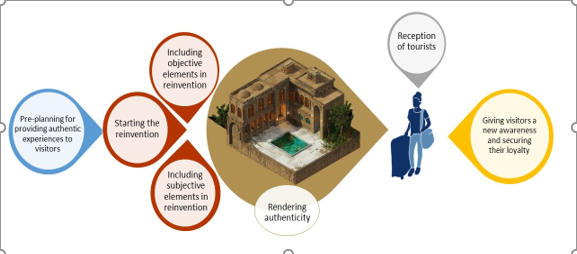Document Type : ORIGINAL RESEARCH ARTICLE
Authors
1 Department of Development and Social Policy, University of Tehran, Tehran, Iran
2 2Department of Women's Social Issues, ACECR, Alzahra Branch, Tehran, Iran
Abstract
BACKGROUND AND OBJECTIVES: A relatively large number of historic (traditional and old) houses have been restored in Iranian cities in the recent period. Of increasing demand in the era of the experience economy, many are used as cafes, restaurants, galleries, ecolodges, etc. Cultural heritage and urban policies have further provided a general framework and some incentives for the restoration and reuse of these houses. Leveraging a tourism development framework, this paper investigated how authenticity could be achieved in practice in the restoration and reinvention of historic houses.
METHODS: A flexible policy research approach was employed to probe the current framework governing the restoration of historic houses. Another part of the analysis was based on a set of semi-structured interviews and field observations targeting restored historic houses in the city of Shiraz. Specifically, interviews were conducted with owners/operators of the most significant category of reused old houses—those turned into ecolodges—along with visitors.
FINDINGS: Based on the fieldwork results, five general recommendations were provided for owners/operators of restored historic houses/ecolodges toward realizing authenticity: there is a need for pre-planning and employment of adequate knowledge and knowhow to provide authentic experiences to visitors; objective elements should leverage creativity, balance tradition and modernity, and give the establishment its own personality; subjective elements should be reflective of local culture, history, and hospitality; a major aim is to have tourists emotionally engaged with the place and easily interact with people, places, and things; and allowing for co-creation could instill an enduring sense of belonging into visitors.
CONCLUSION: Notwithstanding recommendations for owners/operators of restored historic houses, tourism and urban authorities must focus on the creation of a policy framework that encourages the delivery and management of authenticity. Adopting a stronger socio-cultural approach should help to achieve additional regeneration objectives of local economic development through increased interaction among public-sector agencies, non-governmental institutions, local populations (property-owners or tenants), and investors.
Graphical Abstract
Keywords
Main Subjects
OPEN ACCESS
©2023 The author(s). This article is licensed under a Creative Commons Attribution 4.0 International License, which permits use, sharing, adaptation, distribution and reproduction in any medium or format, as long as you give appropriate credit to the original author(s) and the source, provide a link to the Creative Commons license, and indicate if changes were made. The images or other third-party material in this article are included in the article’s Creative Commons license, unless indicated otherwise in a credit line to the material. If material is not included in the article’s Creative Commons license and your intended use is not permitted by statutory regulation or exceeds the permitted use, you will need to obtain permission directly from the copyright holder. To view a copy of this license, visit:
http://creativecommons.org/licenses/by/4.0/
PUBLISHER NOTE
IJHCUM Publisher remains neutral concerning jurisdictional claims in published maps and institutional affiliations.
CITATION METRICS & CAPTURES
Google Scholar | DOAJ | SCOPUS | EBSCO | Internet Archive |Twitter |Mendeley
CURRENT PUBLISHER
Tehran Municipality: Tehran Urban Research and Planning Center



Send comment about this article